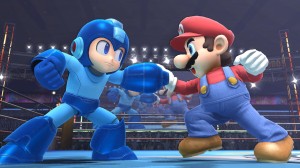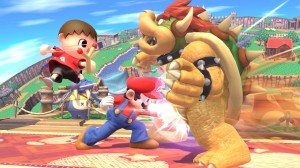
Mega Man is one of the newest additions to the roster and marks the continuing trend of adding third party characters.
In what it appears to be my expertise at this point, this week I will be discussing another Nintendo property. I did mention this one before, but only partially. So now I intend to give the Super Smash Bros. series a good once-over. Masahiro Sakurai, the creator of the Smash series as well as other Nintendo franchises like Kirby, had some interesting ideas when he began making the first Smash Bros. game for the N64. The direction he has since taken the series has been just as compelling, at least for someone who has spent a lot of time with the series. Hopefully examining this will give me a better idea of where the next entry, releasing for both the Wii U and 3DS sometime this year, will lead the series.
The first game, released in 1999 titled simply Super Smash Bros., was not planned to be the mascot fighter it is known as today. Original characters were going to make up the roster but it was not long into development before it was decided that Nintendo characters would make the game more attractive in the same way the Mario Kart series is. The game’s unique battle mechanics based on ring-outs and its simple control scheme added to the appeal of what had become a mascot fighting game. However Nintendo was not entirely secure in its own decision when releasing the game to the west. Avid Smash players might recall the distinctive sounds made in the game when a hit landed on an opponent. These sounds, akin to bowling pins being knocked around, were added in for the western release to give the game a more surreal and comedic tone. Apparently Nintendo was worried about the game appearing too violent. With a playable roster of only eight characters, the original Smash was a much simpler game than the following games in the series. Yet this does not mean the game was wanting for depth. Though lacking many of the options of the later games, the original Smash could become reasonably competitive.
But not nearly as competitive as its direct successor, Super Smash Bros. Melee released in 2001. Melee has become the hardcore darling of the series over the years, and for good reason. It introduced several new mechanics that added to the gameplay without taking anything away. Spot dodging, air dodging, side-B special moves, directional shielding, high and low throws, and the list goes on of new mechanics that were added. With twenty five playable characters, Melee was a huge step up from the previous entry even for people who only casually enjoyed the games. A more robust single player mode was also added, as well as an achievement-based trophy system that awarded the player trophies along with some Nintendo history trivia for completing certain challenges in the game. At high level play, Melee still stands head and shoulders above the rest in the series thanks to several key ingredients that make for a good skill-based competitive fighting game. Many of these elements only became more easily definable when they were taken out or changed in the next game in the series. And despite some valiant efforts to move the tournament scene on to the newest entry, the real competitive scene still remains with Melee to this day. What grew out of Melee was the single fastest fighting game ever made, in terms of actions per minute executed by top players, that put high level play on a skill parity with high level Starcraft play. Other fighting games may require more complex button combos, but none require the player to consistently act and respond with frame-perfect timing at sixty frames per second.
So what did the notorious Super Smash Bros. Brawl “take away” from the series, exactly? Released in 2008, Brawl was developed at a point at Nintendo when they were seemingly afraid of their own success and ability make a compelling game. As a result, Brawl was deliberately handicapped in several ways in a baffling attempt to keep the game from being too competitive and thereby intimidating. The game’s online setup, even by Wii standards, was remarkably poor. Random matchmaking did exist but no names could be shared, even though hackers later proved that data was being transmitted but just not displayed. The quality of the online mode also suffered from hideous lag not present in other online Nintendo games, like the similarly de-fanged Mario Kart Wii. On the gameplay side, Brawl was given a much floatier and slower feel. Aside from simply slowing gameplay down, this also meant that it became harder to knock out an opponent and that nearly every character in thirty five are able to recover to the stage from the edge of the screen. As a result, a typical competitive match of Brawl, such as they are, are only played with three lives (or “stocks”) instead of Melee’s four. Hitstun, the variable time a character is left unresponsive after a hit, was nearly removed entirely and with it went most of the comboing potential of the game. This all leaves out the ubiquitous “tripping”, which any Brawl player would know about and for which there is no defending.
It is for those reasons that today I sit in very cautious optimism for the next entry in the series, which is apparently titled Super Smash Bros. for the 3DS/Wii U and with a current release date of TBA. The drip feed of info from the official website, which is not dissimilar to Brawl’s own online promo site before its release, helps to keep this game in my mind. Every so often something interesting will be announced, a new character or item or stage. But I am left wondering if this will be made by the Sakurai that made Melee or the Sakurai that made Brawl. Right off the bat the game has an uphill battle with me simply because I cannot use my GameCube controller to play it. A seemingly small complaint, but one made bigger when I recall that I bought controllers for use only in Melee and Brawl, such were those games’ strain on the controllers. Not to mention the years and years of muscle memory built around the GameCube’s controller layout means I might not have the easiest time adapting to this new game. And though the friends I have played Smash with over the years will likely never get Wii Us, I do not doubt I will find fun in this game on some level. Will it top Melee and bring a return to the fastest fighting game ever made? Probably not, but I am leaving room in my expectations to be pleasantly surprised.
How much have you Smashed, dear readers? I started with the original, sat on a couch with a bunch of my friends in Middle School. Have you played all of the games in the series so far and do you intend to get the newest one? If so, which? 3DS? Wii U? Both? Personally, I have my doubts about how well the game can work on the 3DS, but we can leave that discussion in the comments. So comment!
